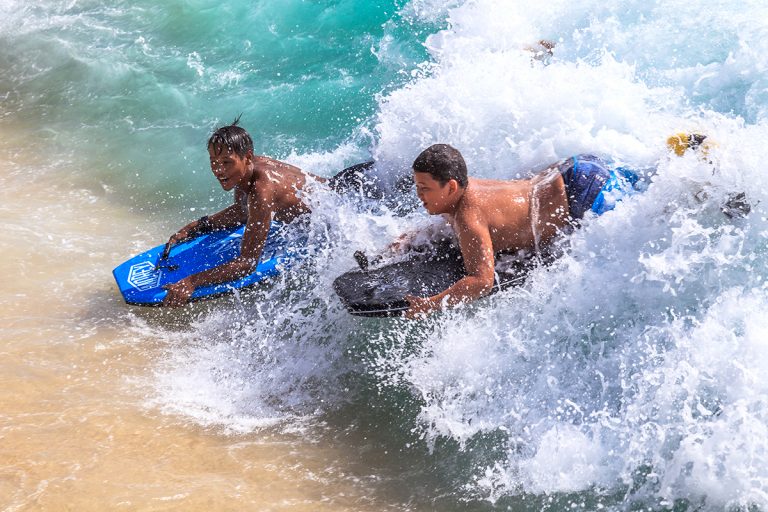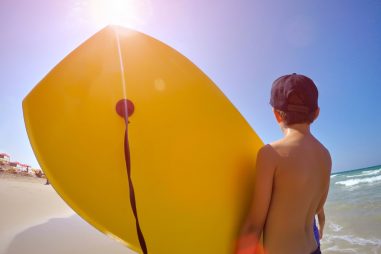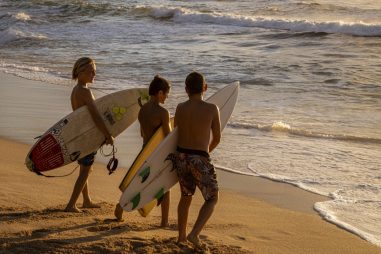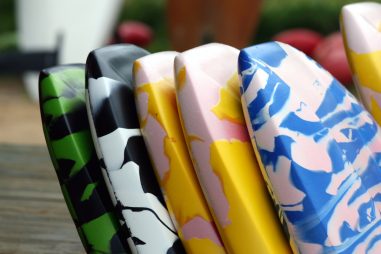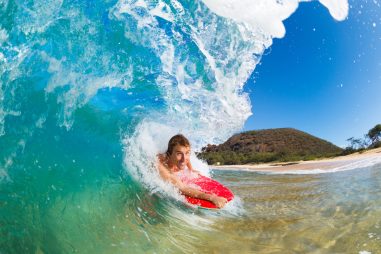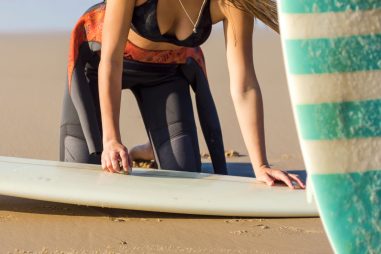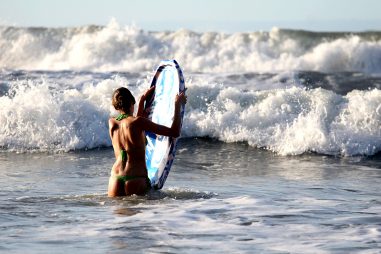Boogie boarding continues to gain popularity from people all over the world. But as with all water and board sports, you would need at least good water and weather conditions to be able to have an enjoyable experience. If you want to know how to catch and ride a wave with a boogie board, what kind of wave and tide is best for boogie boarding, and if you can boogie board in the pool, then read on!
How Do You Catch a Wave with a Boogie Board?
Before you even try to catch a wave with your boogie board, you should first learn how to read the waves. This is important because before you can even catch a wave, you should be able to paddle into it before it breaks, and you can only do this if you know where to wait. Catching a good wave would mean that you should be the perfect distance away from it.
Assuming you’re at the perfect distance away from your wave of choice, here’s what you should do:
- Paddle: If the wave is a good 5 feet away from you, then you should start paddling, paddling, paddling! You can choose to paddle with your arms, your legs, or both. Your paddling velocity is also affected by how fast the wave rolls in. If you choose to catch and ride smaller waves, then you do not need that much velocity. However, if you are aiming for larger and steeper waves, you must put more thrusts into your paddling to be able to reach, catch, and ride it on time.
- Choose a direction: It’s important that you choose the direction that you want to go to when you catch the wave. While doing so, you have to be able to maintain control of your board so that you will not experience being wiped out. You should shift your weight to the direction that you have chosen. Do this by applying pressure with your inside hip and elbow. Always keep your outside hand on the nose of the bodyboard. With your inside hand, grip the rail about one-third of the way down.
- Gain speed: Once you have decided which direction to go to, you should do your best to build your speed until you catch a wave. To ensure that you won’t slide out of your boogie board, you have to make sure that the nose won’t drop in the water and that you have enough wax applied to your boogie board.
Once you are able to successfully catch a wave, you can now choose to a) ride it out into the shore or b) do a cool trick.
How Do You Ride a Wave on a Boogie Board?
Once you get the hang of catching the wave, you can now practice riding it. Once you have chosen the wave that you want to ride, you should point the nose of your boogie board towards the direction of the beach. You must remember to do this before the wave starts to break.
You also have to make sure that you are paddling and kicking in the same direction as the wave. If you successfully do this, you would be able to feel that you are moving and riding the wave towards the beach.
You would know that you have successfully ridden the wave when you do not need to kick or paddle anymore. Since you are riding on top of the wave, the wave will move you.
What Size Waves Are Good for Boogie Boarding?
Choosing the waves is a crucial part of boogie boarding. Generally, you should choose a small, smooth wave that is not too powerful. It is recommended that you catch and ride a wave that is not more than 2 feet or 61 centimeters high.
You should choose a wave that you know you can ride and one that you do not find intimidating, especially if you are a beginner. You should always choose safety when choosing a wave, and you should opt for more rideable waves when you are just starting out in the sport.
Where Are the Best Waves for Boogie Boarding?
The general consensus is that beaches with rocky ocean floors have the best waves that are perfect for boogie boarding. This may be right but note that these waves are more suited to more experienced boogie boarders.
For beginners, however, it is recommended that you practice on more sandy beaches. This is because sandy beaches produce waves that are better for people that are just starting out with the sport.
How Do You Boogie Board Small Waves?
Catching small waves with boogie boards is pretty much textbook. You paddle, catch, and ride the wave out into the shore. You are also free to choose the position that you would take in boogie boarding small waves. You can do a prone position or you can do a drop knee position, whichever you are comfortable with.
Small waves are especially good for beginner and young boogie boarders. This kind of wave can is more conducive when starting out with this sport.
Can You Boogie Board on Big Waves?
Generally, boogie boarders can enjoy the sport in all kinds of waves which means that you can definitely boogie board on big waves. Riding big waves is said to be one of the coolest things that you can ever do on a boogie board.
However, you should always remember that beginners and young boogie boarders are better off enjoying and starting out with smaller waves. Bigger waves are more suited for experienced and advanced boogie boarders.
How Do You Do a Big Wave on a Boogie Board?
To ensure the success of boogie boarding on a big wave, boogie boarders usually perform this trifecta to perfection—catching a wave, staying on a wave, and exiting a wave. These are basically the same steps that you should follow when boogie boarding on small waves, but because you are dealing with significantly bigger waves, you should have utmost focus, and you should have mastered the skills already.
You should also remember to use the right equipment when attempting to boogie board on big waves. First, make sure that you have a good board. You don’t need the best board out in the market, but you need to make sure that your board is not flimsy. Your boogie board should have a strong core, channels for extra grip, rail ratio, stringers, tail design to help you with control and speed, and slick.
Next, make sure that you would be boogie boarding using fins on your feet. Fins can help your body maneuver quicker, and they can help your stability. Aside from that, fins help you a lot in catching big waves by adding speed to your movement.
Lastly, make sure that you are using a leash. When you try to ride big waves, being wiped out is a strong possibility, and this may result in a lost board. A leash will ensure that this will not happen.
What Is the Biggest Wave Ever Boogie Boarded?
The biggest wave ever boogie boarded measures a whopping 45 feet. This massive wave was caught by famous Brazilian bodyboarder Magno Passos when he was boogie boarding in Pe’ahi Jaws, Maui, in 2016. Passos is known for taking on massive waves, but this is by far the biggest wave he, or anyone, has ever caught and successfully ridden on.
What’s even more unbelievable is that Passos rode this wave without any life vest or any rescue team on the side. He had also said that he had lost his fins halfway down the face of the wave.
What Is the Best Tide to Boogie Board?
It is important to pay attention to the tides because they affect the size, quality, and speed of the waves. It’s hard to say the absolute best tide to boogie board since different beaches and spot have their own special tide times and condition wherein they would be producing waves that you can ride.
As a beginner, you should pay extra attention to reading and understanding the surf report. This will help you figure out when’s the best time to visit the beach.
Should You Boogie Board at High or Low Tide?
While you can boogie board at both high and low tide, beginners are often advised to boogie board during the latter. But in any case, you should pay better attention to the special tide times that a beach has. This is because this is the exact time that it will be producing breaking waves that are enough for you to ride on.
You should also reconsider going to beaches where you can experience good waves during extremely low tides. Sure, the place may have amazing waves, but going in during extremely low tides can still be potentially dangerous because you would be boogie boarding in shallow waters that are very close to the seafloor.
When Is the Best Time to Go Boogie Boarding?
Since the waves are affected by several factors, there is actually no “best” or “perfect” time to go boogie boarding. As you know, the tides affect the size, quality, and speed of the waves. Unfortunately, there is no tidal schedule that you can check with. Another factor that affects the waves is the wind, and the wind does not follow a time table.
Generally, paddlers, including boogie boarders, often choose to set out into the water during the early mornings. This is because there is less wind to affect the waves, especially if it is blowing in the wrong direction.
Again, understanding the surf report can help you in determining whether it is worth your time to visit a specific beach at a given time.
How Do You Use a Boogie Board at the Beach?
The basic moves for boogie boarding at the beach are pretty similar for both beginners and advanced boogie boarders. These basic moves include catching a wave, staying on a wave, and exiting a wave. Catching waves and riding them out is generally a lot easier than boogie boarding further out.
If you are lucky and you went to a beach with a) waves breaking near the shore and b) has a sandy bottom, it would be easier for you to set yourself up and catch a wave. You can catch the wave by staying and standing where the waves start breaking.
Once you spot a wave that you can easily catch, you can jump on your board. Make sure that your chest and stomach are positioned on the deck of the board and that the board lands on the face of an oncoming wave.
If you have set your position and your board correctly, then you would feel it easily gliding along the surface of the wave. If you are a beginner, you should start with smaller waves to ensure your safety. Advanced boogie boarders usually take on bigger waves because they can ride them further.
How Do You Boogie Board in the Ocean?
If the waves are breaking further out and not close to the beach, you would need the help of fins. The thing about boogie boarding on the beach is that it is easy to spot if it has a sandy bottom, but when you paddle further out, it is possible that the bottom is not sand. This means that it would be impossible for you to stand and catch a wave.
You should add power to your legs as you propel yourself, and you should be able to sync your speed with the oncoming wave. If you are successful in catching the wave, you would easily glide with it as it breaks.
Boogie boarding in the ocean takes skills which makes it more of an activity for experienced boogie boarders. Beginners are advised to stay as close as possible to the shore, but as you continue with your lessons, you would be able to enjoy boogie boarding in the ocean and with bigger waves.
Can You Use a Boogie Board in the Pool?
While boogie boards are generally known for riding waves, people have come to enjoy boogie boarding in the pool. Granted, the experience might not be the same, but it can still be quite enjoyable, especially for young kids.
But like boogie boarding on the beach or in the ocean, doing the sport in the pool can be potentially dangerous, especially if done without adult supervision or pursued recklessly.
What Do You Do With a Boogie Board in the Pool?
Because there are no waves in the pool, you sadly cannot have the full boogie boarding experience. What people usually do to be able to ride the board is to place it on one end of the pool, doing a sprint, and jumping on the board, allowing it to glide over the water. If you think that you are not athletic enough for this, you can just hang around and float with your boogie board.
Remember that boogie boarding in the pool does have its risks. It is easy to fall and to hit your head on the concrete edges of the pool if you ride it recklessly.
Whether you try boogie boarding at the beach, in the ocean, or in the pool, it is important to always think about your safety first.

